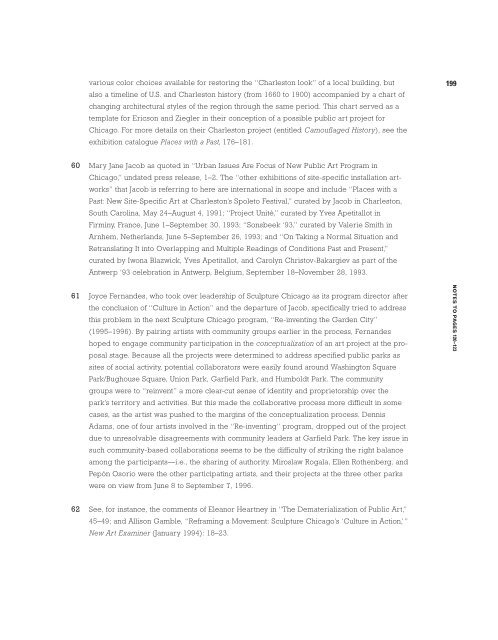ONE PLACE AFTER ANOTHER - Monoskop
ONE PLACE AFTER ANOTHER - Monoskop
ONE PLACE AFTER ANOTHER - Monoskop
Create successful ePaper yourself
Turn your PDF publications into a flip-book with our unique Google optimized e-Paper software.
various color choices available for restoring the “Charleston look” of a local building, but<br />
also a timeline of U.S. and Charleston history (from 1660 to 1900) accompanied by a chart of<br />
changing architectural styles of the region through the same period. This chart served as a<br />
template for Ericson and Ziegler in their conception of a possible public art project for<br />
Chicago. For more details on their Charleston project (entitled Camouflaged History), see the<br />
exhibition catalogue Places with a Past, 176–181.<br />
60 Mary Jane Jacob as quoted in “Urban Issues Are Focus of New Public Art Program in<br />
Chicago,” undated press release, 1–2. The “other exhibitions of site-specific installation art-<br />
works” that Jacob is referring to here are international in scope and include “Places with a<br />
Past: New Site-Specific Art at Charleston’s Spoleto Festival,” curated by Jacob in Charleston,<br />
South Carolina, May 24–August 4, 1991; “Project Unité,” curated by Yves Apetitallot in<br />
Firminy, France, June 1–September 30, 1993; “Sonsbeek ‘93,” curated by Valerie Smith in<br />
Arnhem, Netherlands, June 5–September 26, 1993; and “On Taking a Normal Situation and<br />
Retranslating It into Overlapping and Multiple Readings of Conditions Past and Present,”<br />
curated by Iwona Blazwick, Yves Apetitallot, and Carolyn Christov-Bakargiev as part of the<br />
Antwerp ‘93 celebration in Antwerp, Belgium, September 18–November 28, 1993.<br />
61 Joyce Fernandes, who took over leadership of Sculpture Chicago as its program director after<br />
the conclusion of “Culture in Action” and the departure of Jacob, specifically tried to address<br />
this problem in the next Sculpture Chicago program, “Re-inventing the Garden City”<br />
(1995–1996). By pairing artists with community groups earlier in the process, Fernandes<br />
hoped to engage community participation in the conceptualization of an art project at the pro-<br />
posal stage. Because all the projects were determined to address specified public parks as<br />
sites of social activity, potential collaborators were easily found around Washington Square<br />
Park/Bughouse Square, Union Park, Garfield Park, and Humboldt Park. The community<br />
groups were to “reinvent” a more clear-cut sense of identity and proprietorship over the<br />
park’s territory and activities. But this made the collaborative process more difficult in some<br />
cases, as the artist was pushed to the margins of the conceptualization process. Dennis<br />
Adams, one of four artists involved in the “Re-inventing” program, dropped out of the project<br />
due to unresolvable disagreements with community leaders at Garfield Park. The key issue in<br />
such community-based collaborations seems to be the difficulty of striking the right balance<br />
among the participants—i.e., the sharing of authority. Miroslaw Rogala, Ellen Rothenberg, and<br />
Pepón Osorio were the other participating artists, and their projects at the three other parks<br />
were on view from June 8 to September 7, 1996.<br />
62 See, for instance, the comments of Eleanor Heartney in “The Dematerialization of Public Art,”<br />
45–49; and Allison Gamble, “Reframing a Movement: Sculpture Chicago’s ‘Culture in Action,’”<br />
New Art Examiner (January 1994): 18–23.<br />
199<br />
NOTES TO PAGES 120–123

















